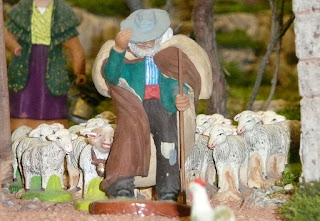The deep bottom of the hole was not found until 1985 when an unmanned submersible touched ground at more than 300 metres down. As well as being the most powerful spring in France it is also the fifth most powerful in the world, turning out millions of cubic metres of water a year.
This energy was once put to use to make paper and the old paper mill is now a museum where you can see how it was made. There is a shop selling paper made in the old fashioned way.
 |
| A shepherd facing the mistral - a popular santon design. |
Also next to the river is a museum of the French Resistance. The village and riverside is so small you can't really miss any of the museums. There is also a museum of santons, which are provencal figurines, very popular especially at Christmas.
There is also a museum for Petrarch, the Italian Renaissance poet, on the site where he wrote his famous Canzoniere, which is a collection of poems to Laura, whom he loved or idolised.
Above the village is a ruined castle, which was built by monks to protect pilgrims.
Sitting at the head of a valley at the foot of the Vaucluse mountains, the village gives the whole French department its name. Vaucluse comes from the Latin Villa Clausa, meaning valley closed.


No comments:
Post a Comment